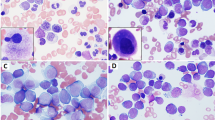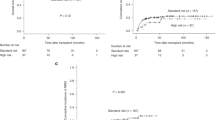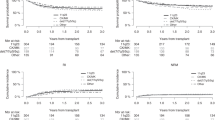Abstract
Infants less than 1 year of age at diagnosis of acute lymphoblastic leukemia (ALL) have a poor prognosis, which has been attributed primarily to a breakpoint in chromosomal band 11q23 or the MLL gene. Most infants with an 11q23 breakpoint have a t(4;11)(q21;q23). We studied the cytogenetics of the leukemia cells of 56 infants on CCG-1883, a single-arm clinical treatment protocol for infant ALL. Twenty-one patients had t(4;11)(q21;q23), seven had other rearrangements with breakpoints in 11q23 (other 11q23), 16 had normal chromosomes, two had t(1;19)(q32;p13), one had >50 chromosomes, and nine had non-recurring structural abnormalities. To determine whether there is a difference in outcome for infants with t(4;11), other 11q23 and the remaining patients, we compared event-free survival (EFS) and other clinical and laboratory features of the above infants. Infants without t(4;11) and those with other 11q23 rearrangements had significantly better EFS than those with t(4;11) (P = 0.007 and P = 0.02, respectively). t(4;11) correlated with age less than 6 months and with CD10 negativity, both of which also were poor prognostic indicators. After adjustment for age, there was still a significant difference in EFS between patients with t(4;11) and those with other 11q23 rearrangements (P = 0.02), and between patients with t(4;11) and those without t(4;11) (P = 0.04). Among CD10 negative patients, t(4;11) was associated with a worse EFS (P = 0.01). Multivariate analysis showed that after adjusting for a variety of clinical and laboratory features, t(4;11) was the most important prognostic factor for poor outcome, and patients with other 11q23 rearrangements had as good an outcome as the remaining patients without t(4;11).
This is a preview of subscription content, access via your institution
Access options
Subscribe to this journal
Receive 12 print issues and online access
$259.00 per year
only $21.58 per issue
Buy this article
- Purchase on Springer Link
- Instant access to full article PDF
Prices may be subject to local taxes which are calculated during checkout
Similar content being viewed by others
Author information
Authors and Affiliations
Rights and permissions
About this article
Cite this article
Heerema, N., Sather, H., Ge, J. et al. Cytogenetic studies of infant acute lymphoblastic leukemia: poor prognosis of infants with t(4;11) – a report of the Children’s Cancer Group. Leukemia 13, 679–686 (1999). https://doi.org/10.1038/sj.leu.2401413
Received:
Accepted:
Published:
Issue Date:
DOI: https://doi.org/10.1038/sj.leu.2401413
Keywords
This article is cited by
-
The KMT2A recombinome of acute leukemias in 2023
Leukemia (2023)
-
AFF3 upregulation mediates tamoxifen resistance in breast cancers
Journal of Experimental & Clinical Cancer Research (2018)
-
The MLL recombinome of acute leukemias in 2017
Leukemia (2018)
-
Cytogenetics and outcome of infants with acute lymphoblastic leukemia and absence of MLL rearrangements
Leukemia (2014)
-
The MLL recombinome of acute leukemias in 2013
Leukemia (2013)



